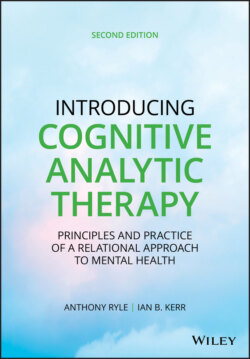Читать книгу Introducing Cognitive Analytic Therapy - Anthony Ryle - Страница 36
The Clinical Aims of CAT
ОглавлениеThe aims of CAT therapists are, in a sense, modest. We seek to remove the “roadblocks” that have maintained restriction and distress and have prevented the patient's further growth, and we aim to assist in the development of more adequate “route maps” and of ways of being and of living life. This occurs partly through the experience of a new, benign, therapeutic relationship. In so doing we also aim to engender some hopefulness where previously there may have been little or none. But we do not offer to accompany the patient along the road. Obstacles to change are various and in CAT are seen to include: self‐reinforcing ineffective procedures; restricted, avoidant, or symptomatic procedures; sabotaging inner critical “voices”; and disconnected, dissociated Self processes. We do not believe we should seek to explain, let alone claim to share or replace, the wisdom and creativity of artists, writers, and philosophers. CAT also developed as a pragmatic model. In the inner‐city London out‐patient service where CAT developed, it appeared to be a satisfactory treatment for over two‐thirds of patients and of some benefit to many of the remainder. Similar outcomes are reported in naturalistic studies in other countries (e.g., Garyfallos, Adamopoulou, & Mastrogianni, 1998) and in more recent comparative studies in the UK (e.g., Marriott & Kellett, 2009). Some of these went on go on to further treatment, such as more CAT, group therapy, or cognitive‐behavioral work on unrevised procedures, assisted by prior reformulation (Dunn, Golynkina, Ryle, & Watson, 1997). More recent outcome data suggests similar results are being obtained across an increasing range of patient problems, severity, and settings (see Calvert & Kellett, 2014). It may also be that CAT is more effective for some patients if undertaken over a somewhat longer time, or in separate blocks with intervals. Its combination or alternation with other interventions, such as creative therapies, psychodrama, or group work, would almost certainly be helpful for patients who are hard to engage emotionally or who need more time to explore alternatives. Further and ongoing research is of course needed, although funding and support remain in general hard to find for psychotherapies, and notwithstanding that some approaches appear more “politically” acceptable and better promoted at any given time.
Which aspects of CAT are the effective ingredients in successful therapy has not been fully demonstrated, but research summarized later in the book has shown that the reformulation process can produce accurate summaries of key issues with good inter‐therapist reliability (see Chapter 8), although its impact appears, perhaps unsurprisingly, to vary for different patients with different problems. Research has also shown that systematic linking of “transference–counter‐transference” enactments (seen as representing a sub‐set of RRs and RRPs) to the reformulation is associated with good outcome (see Chapter 8). Our belief is that the main factors associated with good outcome include: (a) the experience of a benign and collaborative, although at times challenging, therapeutic relationship; (b) as part of this and contributing to it, the joint creation and use of reformulation tools (in written and visual form) and ongoing use of them in and around therapy; and (c) the internalization of these tools and their meanings in the course of and following a collaborative and non‐collusive relationship. These factors cannot be isolated from the other features of the theory and practice that allow intense but contained connections between patients and therapists, and of course the overall systemic and socio‐cultural context of therapy.
To end this chapter, we present an abbreviated and revised account of a typical CAT therapy in order to illustrate its stages and the use of the various tools.
